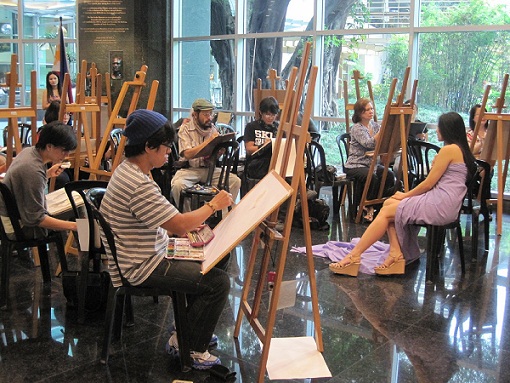Text and photos by ELIZABETH LOLARGA
 EVEN seasoned painter Jonahmar Salvosa admits that watercolor is a medium difficult to master.
EVEN seasoned painter Jonahmar Salvosa admits that watercolor is a medium difficult to master.
The Agos Kulay Maynila president said, “It is the hardest of all the media. If you make a mistake, that’s it. You can’t paint over your mistake or erase it. You have to start with a new sheet of paper. A mistake can be spotted, unless you’re developing a new style or venturing into the abstract.”.
He described watercolor as having “a mind of its own. It takes awhile before you can tame it.” When would-be painters ask him for lessons, he starts them off with watercolor. After a few sessions, even only three days, depending on their interest and commitment, they can level up to oil or acrylic. He said, almost jokingly, “Instant artist agad. They learn three media in one setting.”
Agos Kulay (Watercolor Society of Manila) has been around since 1992. Its on-spot portrait sessions used to be held weekly at the Army and Navy Club in Manila before the building’s renovation.
 Salvosa wrote to the Ayala Museum management. The group now holds its portrait sessions at the museum lobby every Friday afternoon which is when most members have a more unhurried schedule. Other times they go for plein air painting, one that is done in the open outside Metro Manila.
Salvosa wrote to the Ayala Museum management. The group now holds its portrait sessions at the museum lobby every Friday afternoon which is when most members have a more unhurried schedule. Other times they go for plein air painting, one that is done in the open outside Metro Manila.
Among the regulars are Joel Tabuena, Louie Fernando, Zada Ong, Myra Caymar, Eileen Escueta, Rona Chua, Benhur Cabana, Donato Mejia Alvarez, Minda Santillan, Mardy Aguilar, Taj Tajanlangit Locher.
Chua, whose former medium was oil, switched to watercolor when she turned older. “I no longer like the smell of oil and turpentine. Everyone in the house complains. Watercolor is easy to clean and take around.”
Agos Kulay spearheaded “sketch for a cause” with super typhoon Yolanda survivors as the beneficiaries during the first art fair at Greenfield District Central Park in Mandaluyong.
 Salvosa recalled, “My friends and I were having dinner in this Makati restaurant. They asked to have their portraits made. I told them, ‘Pagbibigyan ko kayo if you donate the money to Yolanda survivors. They agreed and queued up. I was able to collect and turn over the funds. The response was so good I asked the Agos group to hold a sketching for a cause with all proceeds going to Yolanda survivors. Sa awa ng Diyos, ang daming pumila at di nga namin nakayanan hanggang gabi.”
Salvosa recalled, “My friends and I were having dinner in this Makati restaurant. They asked to have their portraits made. I told them, ‘Pagbibigyan ko kayo if you donate the money to Yolanda survivors. They agreed and queued up. I was able to collect and turn over the funds. The response was so good I asked the Agos group to hold a sketching for a cause with all proceeds going to Yolanda survivors. Sa awa ng Diyos, ang daming pumila at di nga namin nakayanan hanggang gabi.”
Loren Burgos, actor, dancer and former Mutya ng Pilipinas contestant, sat for the watercolor group’s session recently, her first experience of the sort. She recalled how she met Jonah who was a judge during her first pageant in the Philippines. “We added each other on Facebook. I discovered that he was also an artist. I was interested in joining his group of painters so I asked him if I could be a member. He said yes and persuaded me to pose.”
She felt nervous because the museum lobby was public space and visitors stared at her. She added, “The artists were so close to me I could see their faces and overhear their conversations. But the underlying reason for being nervous was the purple sheets. They made me look like I was naked underneath!”
After a few minutes, she became comfortable, focused on an object and imagined herself on a beach, looking at the sunset. When the two hours were up, the artists gave her their signed works as tokens (they pay their models this way). Burgos said, “I was impressed to see the works. Each had his or her own style.”
 Salvosa explained why a painter needs to be part of group sessions with live models,
Salvosa explained why a painter needs to be part of group sessions with live models,
“Sometimes it’s hard to be alone doing a portrait. There’s no challenge, no encouragement, no time pressure, no development, no coaching. It’s good to have someone with whom you can explore possibilities in doing live portraits.”
Many are skilled in doing portraits based on a photograph. He said this was easy because “measurements, light and shadow are established. When doing live portraiture, you find your self groping. Otherwise, the nose may come out longer than it is, the eyes larger or rounder than normal. Practice is important. Out of ten who can copy from a picture, only three or four can actually do a live portrait.”
He remembered a known portraitist who was good at copying from pictures and who once sat with them. One hour had passed, but the guy was still doing lines and proportions while the others had finished their works.
That is why Salvosa nags Agos Kulay members to sharpen their skills, saying, “A still life you can do at home, and you can turn your spouse, child or sibling into your critic. It’s different with a live model.”

